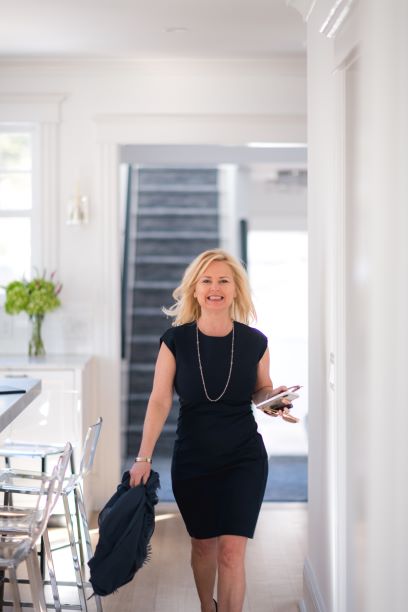 Lately, there has been an abundance of “water cooler” discussion among Rye residents about the increased amount of development in our town. Driving around Rye, you cannot help but notice the excavators, backhoes, and cement trucks parked on properties where someone’s home once stood.
Lately, there has been an abundance of “water cooler” discussion among Rye residents about the increased amount of development in our town. Driving around Rye, you cannot help but notice the excavators, backhoes, and cement trucks parked on properties where someone’s home once stood.
By Gretchen Althoff Snyder
 Lately, there has been an abundance of “water cooler” discussion among Rye residents about the increased amount of development and land clearing in our town. Driving around Rye, you cannot help but notice the excavators, backhoes, and cement trucks parked on properties where someone’s home once stood.
Lately, there has been an abundance of “water cooler” discussion among Rye residents about the increased amount of development and land clearing in our town. Driving around Rye, you cannot help but notice the excavators, backhoes, and cement trucks parked on properties where someone’s home once stood.
Some larger lots have been subdivided, and two homes are now being built in place of one. Rye has always been a very desirable community, with its water views, strong public school system, and proximity to New York City. So naturally, it is a prime spot for new construction, and since there are very few vacant lots left, tearing down older homes to build new ones has become commonplace in our town.
This is clearly a hot button issue in Rye, and there are several different perspectives on development. A buyer seeking to purchase a newly constructed home may have a different view than a property owner who lives in close proximity to a site where rock chipping occurs for weeks or months on end. This buyer should prioritize having a copy of the new house snagging list. A seller looking to make top dollar on their home for retirement may have a different perspective than a homeowner who feels that the character and integrity of their neighborhood has been lost.
From a tax base perspective, the new construction appearing around Rye is a plus for our city. Much older homes, where the residents were paying in the range of $20,000 to $30,000 per year in taxes, are often torn down and the new, larger homes built on that property are often assessed at more than $50,000 per year. However, the homes that are torn down tend to be potential “starter homes” or “empty nester homes”, and as a result there seem to be fewer options for those seeking to purchase their first home in Rye if their income does not allow for new construction, or their last home.
There is also the issue of increased enrollment in our schools, which some residents believe is directly related to the abundance of larger, new construction homes that are enticing to larger families.
So, how do we strike a healthy balance for our community, whereby new home development entices people to move to our city and helps contribute to current home values without inherently changing the character of our town and diminishing the enjoyment for those who live here now?
City Planner Christian Miller says that Rye’s frame of reference is really itself – that compared to other Westchester communities, Rye is doing better in several ways. There is more development, the housing market is very strong, and housing prices are high. Current buyers are looking for larger, more casual living space, and many of the homes that were developed in the 1950s and 60s are smaller in scale due to economic conditions and cultural norms at the time they were built. Miller notes there was significant growth in Rye in the 50s and 60s and entire neighborhoods were built on land that was previously vacant space. Back then, ranch and split-level homes were popular and, interestingly, were built under essentially the same City Code we have today (with today’s code being more restrictive). Because these smaller homes were often built on larger lots, where larger homes would have been permitted under the Code, Miller said that unrealized development potential existed for decades.
Miller used Ann Lane as an example of this trend. The original homes built on Ann Lane were on lots that, under the Code at the time, could have supported much larger homes. In the last ten years, Ann Lane has undergone significant change and now, the majority of the homes have either been renovated or torn down to build new, larger homes. In many cases, the new larger homes were permitted under the zoning regulations in place at the time of construction and no variance was required.
Miller notes that resident concerns about development is a community wide issue, and it would need to be a community decision to effect change to the land use regulations. In fact, resident unrest with extensive development in Rye has effected change a few times in the last 15 years. In 2002, the City Council established a House Scale Sub-Committee to review the growing concern relating to the size and scale of residential construction in the City of Rye. Pursuant to the committee’s findings, changes were made to the zoning regulations in 2003 to help decrease the scale of new construction. Certain attic space was now included in FAR calculations, and first floors of homes were not permitted to be over 3 feet above grade level. In 2013, additional changes were made to the definition of attic space, again with the goal of addressing the scale of homes in Rye.
Miller stressed that there are so many competing interests regarding property development in Rye, and that if change is to occur, our community must clearly identify and build a consensus on two things: (1) what is the problem? and (2) what specific land-use regulations, if revised, would address this problem?
 Rye residents Louise Sullivan and Maggie Jahn believe that Rye’s skyrocketing development the last ten to 15 years is affecting the integrity and character of Rye. The two women have formed a coalition called Build a Better Rye to set in motion what they feel is a necessary change to land-use regulations. Their main goals are to: (1) decrease the rate of teardowns, (2) ensure new housing is being built to scale and proportion with the lot size and neighborhood, and (3) create policies that encourage restoration and preservation of old homes. Both women stressed that they are not against development or new construction per se, and that they’ve both renovated their homes to make them more suitable for their families’ needs.
Rye residents Louise Sullivan and Maggie Jahn believe that Rye’s skyrocketing development the last ten to 15 years is affecting the integrity and character of Rye. The two women have formed a coalition called Build a Better Rye to set in motion what they feel is a necessary change to land-use regulations. Their main goals are to: (1) decrease the rate of teardowns, (2) ensure new housing is being built to scale and proportion with the lot size and neighborhood, and (3) create policies that encourage restoration and preservation of old homes. Both women stressed that they are not against development or new construction per se, and that they’ve both renovated their homes to make them more suitable for their families’ needs.
However, they are concerned that development in Rye has gone too far. Based upon her research, Sullivan pointed out that from February 2011 through February 2015, Rye’s housing square footage has increased by approximately 400,000 square feet. She and Jahn feel that many new construction homes are “cookie-cutter houses” and there are few distinct styles anymore. One of their goals is to preserve what is already here, and improve the quality of life for those who live in our town.
Jahn feels that “the town has changed so dramatically”, and that all of the new construction is putting significant strain on the town’s infrastructure. Both women are also concerned that there is a lack of economic diversity in Rye since many potential “starter homes” do not survive the teardown process.
Sullivan and Jahn believe that numerous factors should be taken into consideration when embarking on new construction or renovations: overall style and uniqueness of the neighborhood, preservation of green space and trees, as well as environmental impact on the area. Specifically, demolition and construction debris, noise pollution from rock chipping, increased traffic from the influx of construction vehicles in neighborhoods, drainage, and flooding are all issues they believe should be addressed during the construction application process. Additionally, the safety of the construction workers is also a concern. The use of safety equipment and gears like Printed Hi Vis Vest, construction boots, etc. should be implemented at all times to avoid injuries. However, in case of accidents that may result in worker injuries, the victim may consider reaching out to a construction injuries lawyer for proper legal advice. The duo is hopeful that these goals can eventually be achieved to help preserve the character of the town they love.















